Exploring the Intricacies of Ametrine Crystal
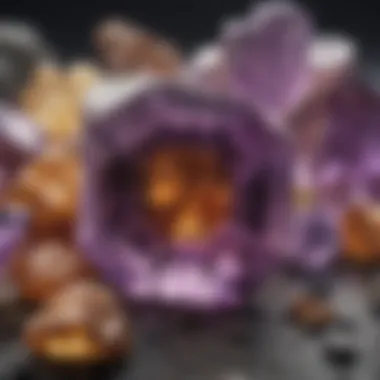

Intro
Ametrine crystal stands out due to its unique composition, merging the properties of amethyst and citrine. This duality not only enhances its aesthetic appeal but also gives it significant metaphysical properties. Understanding ametrine involves examining its geological formation and the specific characteristics that distinguish it. Collectors and enthusiasts are drawn to its vibrant colors and diverse applications.
Featured Collectible of the Month
Overview
Ametrine has garnered attention for its extraordinary beauty and rarity. It typically displays a captivating blend of purple and yellow or orange hues. This appearance is a direct result of the crystallization process that occurs in a specific geological environment. The pricing of ametrine can vary based on quality, color distribution, and size. As a collectible, it holds value not just because of its visual allure but also due to its spiritual significance in many cultures.
Historical Significance
Historically, the significance of ametrine can be traced back to its discovery in Bolivia. The Anahi mine in Bolivia is the most renowned source, where the crystal was first discovered. It became popular in Europe during the colonial period after being introduced by the Spanish in the 17th century. Traditionally, it has been associated with various beliefs and spiritual practices, with many attributing it properties that enhance creativity and balance.
Ametrine's unique combination of energies resonates with both the mind and spirit, making it a sought-after gemstone in the metaphysical community.
Identification Techniques
Visual Characteristics
To identify ametrine, one must look for the following visual signs:
- Distinct bifacial coloration, usually a combination of purple and yellow/orange.
- Clarity levels that range from transparent to translucent.
- Familiarity with the typical shapes, which include beads, cabochons, and raw stones.
Resources for Identification
Collectors often seek tools and resources for accurate identification:
- Online forums such as Reddit can provide community insights and shared experiences.
- Gemological laboratories, which offer services to confirm authenticity.
- Literature from authoritative sources, like articles available on Britannica or Wikipedia.
Geological Origins of Ametrine
The geological origins of ametrine are essential to understanding its unique properties and characteristics. This crystal, a stunning blend of amethyst and citrine, originates from natural processes that occur deep within the Earth. Understanding these origins not only enhances appreciation for the gemstone but also informs collectors about its potential value and rarity.
Formation of Ametrine
Ametrine forms through a unique combination of heat and pressure over a long period. The process begins with the emergence of quartz, a common mineral found in many geological formations. Under specific conditions, including varying temperatures and environments, specific iron traces can enter the crystal lattice, resulting in the distinct colors associated with ametrine. The two color zones, purple from amethyst and yellow from citrine, occur due to differences in oxidation states of iron ions. This duality not only creates aesthetic appeal, but it also reflects a fascinating geological history.
The temperature fluctuations during the crystal's formation play a pivotal role in its coloration. When these conditions are met, ametrine emerges as a rare natural phenomenon among gemstones.
"The beauty of ametrine lies not just in its visual allure, but in the complex natural processes that create it."
Location and Mining Sites
Ametrine is predominantly mined in Bolivia, specifically in the Anahi mine. This location is significant not only for its extensive deposits but also for the quality of the crystals, which are often more saturated in color compared to those found elsewhere. The mining environment influences the clarity and intensity of the crystal's hue. Other notable sites include parts of Brazil, where similar conditions can produce ametrine.
The mining practices at these sites vary, and ethical considerations around them are crucial for collectors to understand. Knowledge about where and how ametrine is sourced can impact its authenticity and market value. Collectors should be diligent in seeking information on the provenance of their stones, as this can play a crucial role in their collecting journey.
Physical Characteristics
The physical characteristics of ametrine crystal play a crucial role in understanding its value and allure. These features not only define the gemstone’s aesthetic appeal, but also influence its market demand. For collectors, recognizing the specific attributes of ametrine can enhance their appreciation and inform their purchasing decisions.
Color Varieties and Gradations
Ametrine is celebrated for its unique color combination originating from the fusion of amethyst and citrine. The most striking feature is its dual coloration, which can range from vibrant purples to golden yellows. The distinct separation of these colors within a single stone often creates striking gradations. Collectors value the stones that display a seamless blend, often referred to as "tricolor" with portions of both purple and yellow intermixed with clear or translucent sections.
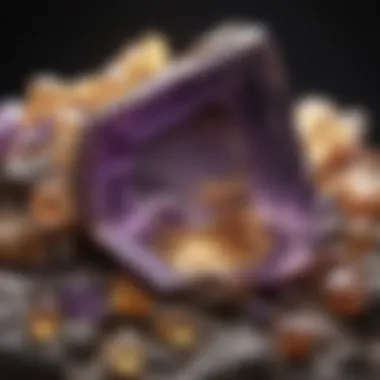

Furthermore, the saturation and clarity of the colors can significantly affect the stone's desirability. Stones with strong, deep hues are generally more sought after than those with pale or washed-out variations. Each color can exhibit different gradations, from soft lavender to deep royal purple for amethyst and light straw to rich golden hues for citrine. This complexity in color makes every piece of ametrine a unique specimen.
Crystal Structure and Composition
Understanding the crystal structure and composition of ametrine enhances an appreciation for its formation and rarity. Ametrine is a variety of quartz, specifically composed of silicon dioxide. It crystallizes in a hexagonal system, which contributes to its prismatic appearance. The internal structure influences how light passes through the stone, often resulting in a striking visual when cut and polished.
The uniqueness of ametrine lies not only in its dual colors but also in how these colors arise during crystal growth. The temperature variations during the formation process in specific geological settings lead to the development of the two distinct hues. This interplay of conditions is what gives collectors a deeper insight into the geological processes that create such fascinating gems.
In summary, the physical characteristics of ametrine, from its vivid color varieties to its remarkable crystal structure, are vital for collectors and enthusiasts. These elements affect both the beauty and value of the crystal, providing depth to the collector’s engagement with this extraordinary gemstone.
Understanding these characteristics is essential not only for valuation but also for identifying genuine ametrine in the market.
Metaphysical Properties
The metaphysical properties of ametrine crystal are essential to understand its significance beyond its physical beauty. Ametrine, with its unique combination of amethyst and citrine, embodies the energies and attributes of both stones, lending it its deeper meanings and potential benefits. This section will delve into the ways ametrine has been perceived in spiritual practices and its relevance to the holistic community.
Chakra Association
Ametrine is often associated with several chakras, primarily the crown and solar plexus chakras. The crown chakra, located at the top of the head, is linked to spirituality, enlightenment, and higher consciousness. Ametrine's lavender hues represent spiritual awakening and connection, allowing individuals to deepen their understanding of themselves and the universe.
The solar plexus chakra, found in the upper abdomen, relates to personal power and self-esteem. The golden-yellow tones of citrine in ametrine stimulate self-confidence and motivation. This dual chakra connection enables the wearer to promote clarity of thought and emotional balance, aiding in discerning one's true purpose.
"Ametrine helps in aligning the mind and spirit, balancing emotions with clarity and intention."
Healing and Protective Qualities
The healing properties of ametrine are often celebrated in wellness and metaphysical circles. It is believed to dispel negative energies and foster a sense of peace and relaxation. Individuals who experience high levels of stress may find comfort in ametrine as it is thought to help eliminate anxiety while promoting a positive outlook.
Moreover, ametrine is considered a protective crystal. It is said to guard against emotional and psychic attacks, providing a shield to those who might feel vulnerable. In physical healing practices, it is thought to alleviate ailments related to the digestive system and enhance overall well-being.
Some potential benefits of ametrine include:
- Enhancing mental clarity and focus.
- Fostering a harmonious environment.
- Supporting personal growth and reducing self-doubt.
Incorporating ametrine into daily practices, whether as jewelry or meditation tools, allows individuals to harness these energizing qualities. Its unique blend offers both healing and empowerment, making ametrine not just a beautiful stone but also a valuable ally in nurturing one’s holistic health.
Cultural Significance
Understanding the cultural significance of ametrine crystal enriches one's appreciation for its multifaceted nature. This gemstone is not only a geological marvel, but it also holds a substantial place in the history, art, and spiritual practices of various cultures. Exploring these connections offers deeper insights for collectors and enthusiasts alike.
Historical Use in Various Cultures
Ametrine has been valued in many ancient societies. The indigenous tribes of South America have utilized ametrine, primarily in spiritual practices. They believed that the vibrant colors of the stone symbolized the balance of energies between the mind and body. It was often carved into talismans, which local shamans used in rituals aimed at protection and healing.
In the 17th century, the conquistadors discovered ametrine in Bolivia, and it became a popular stone among European nobility. These elites often incorporated ametrine into ornate jewelry, which showcased their wealth and status. This trend popularized the stone even further, making it a sought-after gem in the royal courts. Notably, the inclusion of ametrine in royal artifacts signified not just opulence but a connection to spiritual significance.
Modern Interpretation and Use
In contemporary society, the interpretation of ametrine has evolved. It is celebrated for its aesthetic appeal and metaphysical properties. Many people use ametrine in meditation practices, believing that each color in the stone can facilitate diverse energies. Amethyst is often associated with tranquility, while citrine is linked to abundance and optimism. This duality makes ametrine a versatile crystal in wellness circles, bridging the gap between tradition and modernity.
Additionally, ametrine's popularity in jewelry continues to flourish. Designers appreciate its unique color blend and use it in diverse styles, from rings to pendants. This renewed interest reflects a larger appreciation for natural materials, further cementing ametrine's significance in both fashion and personal expression.
"Ametrine embodies the union of amethyst and citrine energies—each serving a distinct purpose in personal growth and self-awareness."
As the gemstone resonates deeply with enthusiasts and professionals alike, understanding its cultural roots enhances its perceived value. Collectors are encouraged to explore both its historical context and modern uses to gain a comprehensive view of ametrine's enduring allure.
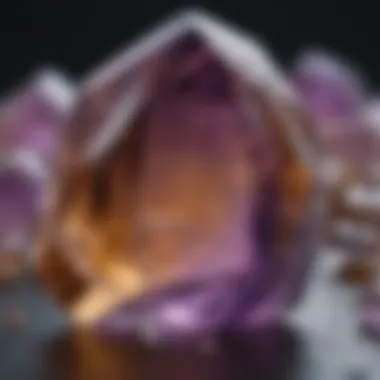
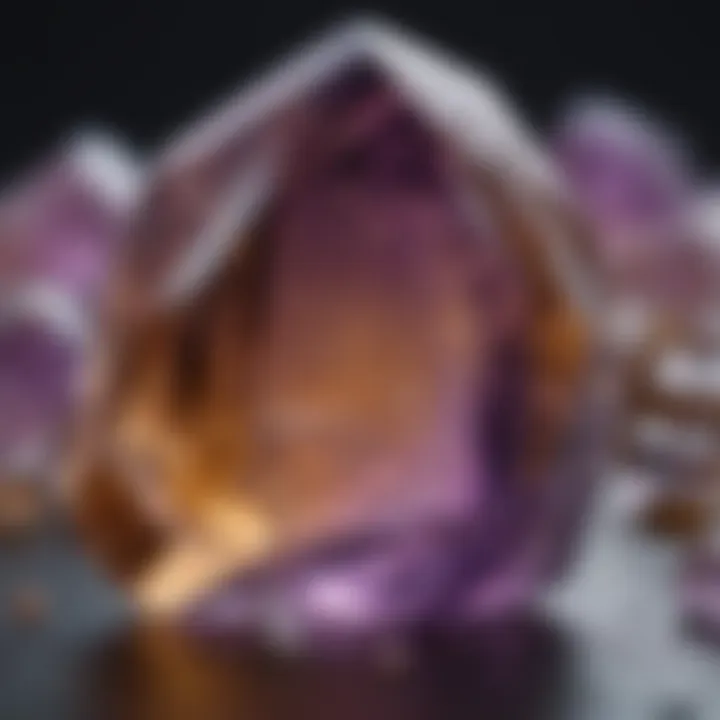
Care and Preservation
The care and preservation of ametrine crystal are crucial components to maintaining its beauty and integrity. Proper care not only enhances the visual appeal of the gemstone but also extends its lifespan, making it a valuable addition to any collection. Ametrinc crystals, owing to their unique combination of amethyst and citrine, can be sensitive to environmental changes. Therefore, understanding how to clean and store this exquisite stone is essential for collectors and enthusiasts alike.
Cleaning Techniques
Cleaning ametrine requires a gentle approach to avoid damage. Here are some effective cleaning techniques:
- Mild Soap Solution: Use warm water combined with a few drops of mild dish soap. Soak the gemstone briefly and then use a soft cloth to wipe it clean.
- Avoid Harsh Chemicals: Do not use strong detergents or chemical cleaners, as they can alter the crystal's color and finish.
- Soft Brushes: If dirt accumulates in crevices, a soft-bristle toothbrush may be useful. Ensure the bristles are not too harsh to prevent scratches.
- Rinse Thoroughly: After cleaning, rinse the crystal under running water to remove any soap residue. Dry the stone carefully with a lint-free cloth.
- Ultrasonic Cleaners: While some gemstones can withstand ultrasonic cleaning, ametrine should avoid this method due to its potential fragility.
Keeping the cleaning process free of abrasive materials will help maintain the crystal's aesthetic and structural integrity.
Storage Guidelines
Proper storage plays a significant role in preserving the quality of ametrine. Here are important guidelines to follow:
- Use Soft Pouches: Store ametrine in a soft pouch or cloth bag to prevent scratches from other gems or objects, ensuring that the crystal remains pristine.
- Avoid Direct Sunlight: Keep the gemstone out of direct sunlight and high temperatures. Prolonged exposure can lead to fading of its vibrant colors.
- Separate Compartment: If possible, dedicate a specific compartment in your jewelry box or display case for ametrine. This keeps it secure and reduces the risk of contact with harder materials.
- Humidity Control: Ideally, maintain a stable humidity level in the storage area. Extreme fluctuations can harm the crystal over time.
- Regular Inspection: Examine stored ametrine regularly to ensure no potential damage has occurred. Look for any chips or cracks that may require attention.
Market Dynamics
Understanding the market dynamics surrounding ametrine crystal is critical for enthusiasts and collectors alike. The gemstone's unique composition, blending the beauty of amethyst and citrine, shapes its presence in the marketplace. As demand ebbs and flows, so too does the value of ametrine. Additionally, awareness of pricing trends and authenticity ensures that collectors make informed purchases, securing a satisfying investment.
Pricing Trends
The pricing of ametrine can be influenced by numerous factors, including geographical availability, size, clarity, and color variation. Notably, premium quality ametrine tends to showcase a balanced mix of purple and yellow hues. The best specimens, often mined in Bolivia, have become synonymous with quality. Historical data indicates that prices can fluctuate based on the rarity of certain qualities, such as vivid coloration and transparency.
Collectively, prices for ametrine range widely, typically from a few dollars per carat for pieces with less desirable qualities to several hundred dollars per carat for extraordinary specimens. Following these trends helps discerning collectors identify a fair market price, enabling them to invest wisely.
- Factors Affecting Pricing:
- Geographic availability
- Size and weight of the stone
- Clarity and color richness
Authenticity and Quality Indicators
Knowing how to distinguish authentic ametrine from imitations is vital for ensuring value in your collection. Authentic ametrine will exhibit natural color zoning, displaying a clear transition between the purple and yellow sections. In contrast, synthetic or treated stones may show unnatural patterns or uniformity.
To evaluate quality, collectors should consider the following indicators:
- Color Separation: Look for a well-defined line between the amethyst and citrine colors.
- Clarity: A truly fine ametrine will be free from inclusions, enhancing its brilliance.
- Cut Quality: A well-cut stone maximizes its color play and brilliance, impacting its overall appeal.
Researching seller reputations and obtaining certificates of authenticity from reputable sources also safeguards collectors against potential fraud.
"Emphasizing quality and authenticity ensures a reputable purchase and enhances the overall value of your collection."
Ametrine in Jewelry
Ametrine, a remarkable gemstone that combines the marvellous qualities of both amethyst and citrine, has gained recognition in the jewelry world. Its unique color and duality attract many enthusiasts. Jewelry designers and collectors often seek attributes that set gemstones apart. Ametrine offers vibrant hues and an appealing mix of meanings. This section will focus on the significance of ametrine in jewelry, covering its design features and popular styles.
Design Features
Ametrine is known for its captivating visual appeal. Its colors can range from a rich purple to a radiant yellow, sometimes appearing in shades all at once. This natural blend offers designers flexibility when creating pieces. Ametrine can be carved into various shapes or left as natural crystals to enhance its allure.
The stone is commonly set in both silver and gold, with each metal bringing out different qualities. Silver highlights cooler tones, while gold complements warmer shades. Faceting is another important design feature; it increases sparkle and allows light to dance across the stone's surface. The most sought-after cut is the mixed cut, which showcases the contrast between purple and yellow. This creating a striking effect that is eye-catching.
Moreover, the transparency of ametrine also plays a role in its design. Well-cut pieces often display clarity that enhances their overall beauty. Choosing the right setting can elevate the stone's presence, positioning it as a statement piece in any collection.
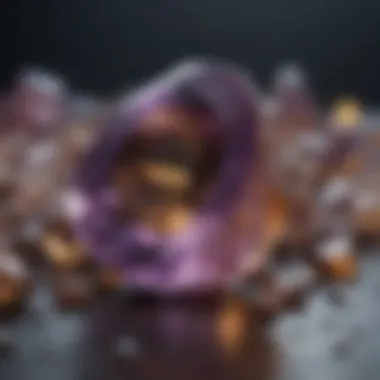
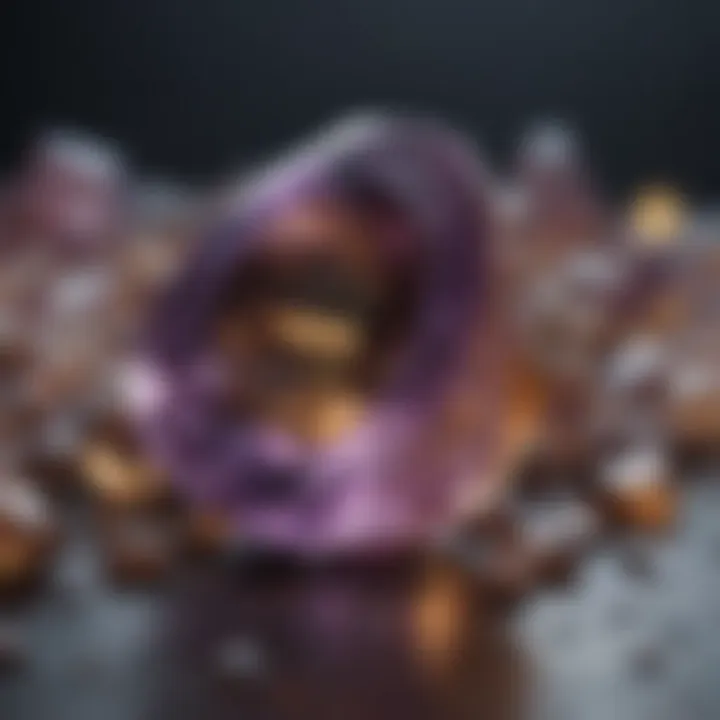
Popular Jewelry Styles
Ametrine is increasingly prevalent across a variety of jewelry designs. With its unique blend of colors, it works well in different pieces, whether in earrings, necklaces, bracelets, or rings.
Earrings featuring ametrine often come in drop or stud styles. This versatility allows wearers to match them with various outfits, from casual to formal.
Necklaces often display larger ametrine stones, typically in a pendant format. A well-crafted ametrine pendant can serve as the focal point of any jewelry collection.
Bracelets can incorporate multiple stones or feature a single larger piece. Children and adults alike enjoy the appeal of ametrine in delicate or bold styles.
Lastly, rings set with ametrine are particularly trendy. They can serve as unique engagement rings or statement pieces for events. Rings featuring intricate designs or combined with other stones make for stunning accessories.
Ametrine combines practicality and beauty, making it a must-have for any discerning jewelry enthusiast.
In summary, the significance of ametrine in jewelry lies in its unique design features and its fit within various popular styles. Jewelers and collectors alike can appreciate the multifaceted qualities of ametrine, which cater to a variety of tastes and preferences.
Ametrine and Collecting
Ametrine, with its captivating hues and unique properties, has become a focal point for collectors and gemstone enthusiasts. Understanding the importance of collecting ametrine lies in its rarity and the distinctive features that set it apart from other gemstones. Collectors appreciate not just the beauty of this stone but also its geological origins and the way it embodies a blend of citrine and amethyst. Each piece can tell a story and reflects a specific moment in the earth's history.
Understanding Rarity
The rarity of ametrine arises primarily from its specific geological formation. This unique crystal occurs in limited locations, predominantly in Bolivia, where distinct environmental conditions allow for its creation. Ametrine is not just a simple combination; it requires a very precise temperature and pressure to form, resulting in a gem that possesses both purple and yellow sections. The fact that these conditions are rare contributes significantly to the stone's value in the market.
Collectors looking for ametrine should consider the different qualities that affect rarity:
- Color distribution: The ideal ametrine showcases both colors in a balanced manner.
- Crystal clarity: High-quality specimens have minimal inclusions and are transparent.
- Size and cut: Larger stones, especially those well-cut to reveal their beauty, are increasingly rare.
Rarity is not solely about the physical attributes. It also involves provenance. Knowing the source of an ametrine piece enhances its collectibility. Stones with a documented history or ones that come from reputable dealers often hold more value over time. In an environment where forgeries are a concern, understanding the rarity contributes to informed purchasing decisions.
Tips for New Collectors
For new collectors venturing into the world of ametrine, effective strategies can foster a rewarding experience. Here are some essential tips:
- Research and Education: Learning about ametrine’s properties, including its geological features and market trends, will guide your decisions.
- Choose Reputable Dealers: Buy from respected vendors or local gem shows. They can provide certificates of authenticity which are vital.
- Start Small: If new to collecting, consider starting with smaller pieces. This minimizes the financial risk and allows for exploration of various types without overwhelming commitment.
- Network with Other Collectors: Join forums and groups on platforms like Reddit or Facebook. Engaging with other enthusiasts can provide valuable insights and support.
- Document Your Collection: Keep a record of your pieces along with any relevant information such as purchase dates and price. This helps you track the growth of your collection and its value over time.
"In the end, effective collecting is not just about accumulation but understanding the stories gemstones hold."
By following these principles, new collectors can build a thoughtful collection of ametrine pieces that not only shine in beauty but also hold lasting value.
Scientific Research on Ametrine
Scientific research on ametrine serves as a crucial aspect of understanding this unique gemstone, linking geology, gemology, and even metaphysical studies. By examining ametrine through a scientific lens, researchers can uncover insights into its formation, physical properties, and potential applications. This section discusses the latest findings and future directions for study, enriching the reader's appreciation for ametrine and its multifaceted nature.
Recent Findings
Recent studies on ametrine have focused on its mineral composition and formation processes. Researchers have identified that ametrine is primarily composed of silicon dioxide with traces of iron, which contributes to its striking color variations. Detailed analysis through spectroscopy has shown varying levels of iron oxidation, responsible for the distinct purple and yellow hues. This scientific method clarifies how ametrine's coloration can shift between the amethyst-like and citrine-like appearances.
Moreover, research has highlighted the geological contexts where ametrine forms. Most ametrine is found in Bolivia, specifically in the Anahi mine. Studies indicate that variations in thermal gradients and pressures during crystal growth lead to the formation of the two colors within the same crystal.
This evidence supports the idea that the conditions during crystallization are fundamental in creating this dual-colored crystal.
Additionally, recent publications have examined the historical significance of ametrine in local cultures, connecting it further to its geological context and the beliefs surrounding its properties. These findings have evolved the narrative around ametrine, positioning it not only as a collectible gem but also as a cultural artifact.
Future Directions in Study
There are significant opportunities for future research into ametrine, focusing on several key areas. Firstly, further exploration into the environmental conditions during ametrine's formation can yield insights into the geological processes affecting other crystals. This could lead to a better understanding of how external factors contribute to unique visual features in gemstones.
Another area is the metaphysical properties attributed to ametrine. Scientific verification through controlled studies is lacking and presents a chance for inquiry. Understanding how these properties can have psychological or even physiological benefits could broaden the appeal of ametrine within wellness communities.
Furthermore, advancements in technology, such as 3D imaging and AI modeling, can aid in analyzing crystal structures in unprecedented detail. New findings might redefine how collectors interpret and evaluate the quality of ametrine.



